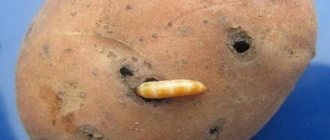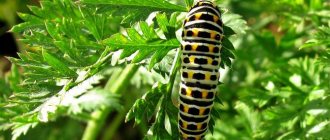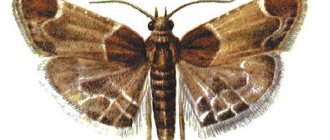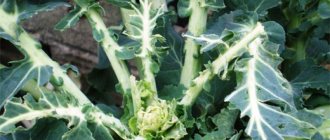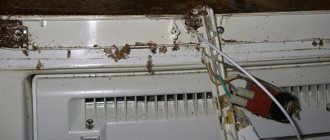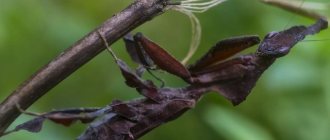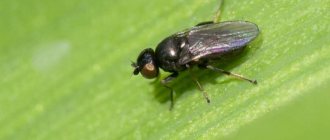Granary pests are a large group of beetles, mites, butterflies and rodents that live in granaries. Rapidly multiplying in huge numbers, they cause significant material damage to agricultural enterprises, eating food supplies and poisoning them with the products of their vital activity. Grain products that are heavily contaminated with insects and rodent droppings are unsuitable for consumption by both people and pets. In addition, grain can become deadly to human health, since mice and rats carry many infectious diseases.
Standardization of grain infestation by barn pests
To determine the contamination of grain, the number of living and active insects for individual species is calculated: the resulting number is recalculated per 1 kg. If weevils and mites are present in a grain crop, the degree of its infestation is determined:
- I degree - 5 individuals (weevils) or up to 20 individuals (mites);
- II degree - up to 10 individuals (weevil) or more than 20 individuals (mites);
- III degree - more than 10 individuals (weevils) or a large number - “felt layer” (mites).
Grain is allowed to be ground into flour or cereals with degrees I and II of infestation by granary pests with preliminary treatment and cleaning. Selling grains infected with stage I mites are purchased at a discount of up to 0.5%.
The presence of insects of other species is indicated in the number of specimens per 1 kg. The norm is no more than 5 copies, then the grain is considered high quality.
Types of pests. Insects
The most extensive class of insects on earth (there are up to 80 thousand species of beetles alone).
It is divided into the orders Coleoptera (beetles), Lepidoptera (butterflies), Orthoptera (cockroaches, grasshoppers), etc. All insects go through four stages of development: egg, larva, pupa and adult form. The adult form, a beetle or butterfly, lays eggs, and after some time the larvae hatch from the eggs. The larvae are very voracious. The adult larva produces a thin thread with which it wraps itself around itself and turns into a pupa (pupates). After some time, a beetle or butterfly (adult form) emerges from the motionless pupa, shedding its shell. The development time of each stage varies among individual insect species. Beetles A characteristic feature of beetles is that they have three pairs of legs. Beetles are easily detected with the naked eye in the adult and larval stages. The most common types of beetles are:
Large flour beetle.
The beetle is large, 1.5 cm long, black or brown. The larva is light yellow in color, 2.5-3 cm long, and hard to the touch. It is sometimes called bonefish. The female lays her eggs in flour, and after 10-14 days the larva hatches from the egg. The larva turns into a pupa, and a beetle emerges from the pupa after 2 weeks. Khrushchak can produce up to two generations in a year.
Small Khrushchak meal.
It is similar to a large beetle, but smaller (3-4 mm), has a reddish-brown color. The larvae reach a length of 6-7 mm. Development from egg to beetle occurs in 27-35 days. Five generations are produced per year. Bread grinder. The beetle is 3-3.5 mm long, light brown in color. The larva is whitish, bent, 5.5 mm long. The female lays up to 60 eggs. Development from egg to beetle—50–70 days. Gives up to four generations per year. Pretend thief. The beetle is dark brown in color, ovoid, 2.5-3.5 mm long. The larva is cream colored. Development lasts 100 days. Gives up to three generations per year.
Khrushchaki - pests of flour
Moorish booger.
The beetle is gray-brown in color, 11 mm long, and has a flat body. The larva is dirty white. The larva emerges from the egg after 10 days and pupates in the spring the following year. Gives one generation per year.
Suriname mucoed.
The beetle is red-brown in color, 3 mm long, the body is flat, elongated. The larva is cylindrical, yellowish-gray in color, up to 4 mm long. Development lasts from 22 to 70 days. It produces two generations per year.
Butterflies: Butterflies include various types of meal moths and moths.
Flour fire.
The butterfly's wings are 22-30 mm long. The forewings are chocolate-colored, with a greenish-yellow stripe in the middle. The back of the wings is dark gray, with a darker stripe along the edges. It produces four generations per year.
Mill fire.
The butterfly's wings are 20-25 mm long. The front pair of wings is ash-gray, with two transverse light stripes. The hind wings are whitish, with a dark border along the edge. Cream-colored caterpillar up to 16 mm long. The female can lay 150-200 eggs. Development from egg to butterfly can last 30-50 days. It produces six generations per year.
Mill fire
Ticks in flour.
Ticks belong to the order Arachnida and do not belong to insects. Several dozen species of mites are known. Their size is insignificant - from 0.2 to 0.8 mm. It is impossible to examine them without a magnifying glass. Stages of tick development: egg, larva, first nymph, second nymph, adult ticks. The female lays from 20 to 600 eggs. The larva transforms into the first nymph after 4-5 days. The full period of development lasts 14-17 days under favorable conditions. The best temperature for tick development is 18-20. The following types of mites are found in flour: flour mite, hairy mite, elongated mite and predator mite. There are three degrees of mite infestation of flour: 1st degree - mites can be counted; 2nd degree - ticks are difficult to count; 3rd degree - mites form a felt mass. With a large number of mites, the flour seems to move and has a honey smell. For pests such as insects and mites to exist, they must have a certain amount of water in their bodies. Pests lose water through breathing and excrement. Replenishment of moisture occurs only through flour. In storage facilities they accumulate in the most humid places (cracks, underground, etc.). The bread borer develops in flour at a humidity of 10-12%, mites - 13%, some types of mites require higher humidity (15-16%). The specified humidity limits are the minimum for the existence of pests. The optimal humidity for their development is higher. The temperature factor is of great importance for the development of insects and mites. This or that temperature can promote intensive activity of pests or, on the contrary, can lead to their death. The Suriname flour beetle, granary moth and others need elevated temperatures; at lower temperatures, mealworms, thief pretenders, etc. can develop. Ticks and insects require oxygen to breathe, which is why they usually accumulate in places where there is access to air. In the inner layers of flour, where carbon dioxide accumulates, pests feel worse. Most insect pests of flour are nocturnal. The mechanical impact on the grain of the working parts of the machines in the cleaning and grinding department leads to the complete destruction of mites and insects present in the grain. But if the walls, floors and similar places in the mills are infested with pests, the ground flour can become infected again.
Mites living in flour
Prevention is the best remedy for barn pests
Proven preventive measures help to successfully combat pests of grain crops:
- Keeping warehouses and granaries clean.
- Constant ventilation of premises.
- Disinfection of grain crops before loading with sulfur dioxide, carbon disulfide, chloropicrin.
- Storing grain in a dry and cooled state without access to atmospheric oxygen, which promotes the development of barn pests.
- Disinsection of equipment and storage facilities with sulfur bombs.
To prevent the development of barn pests, it is necessary to maintain optimal temperature and humidity in the room where the grain is stored. Depending on the type of insect, the lower temperature limit favorable for their reproduction is 6-12 degrees, the upper limit is 36-42 degrees. The moisture content of the grain stored for storage is of great importance: for mites the figure is 13-15%, for other insects - 9-11%. Low humidity and the absence of crushed parts in it lead to the death of most pests in the first weeks of storage.
What is the harm of an insect?
In nature, the grinder feeds on rotten wood, dry and limp grass, and rotten fruit. But when it gets into a human home, it happily eats food and some other objects.
The insect can parasitize on:
- any bakery products;
- books;
- medicinal herbs;
- medicinal powders, tablets;
- grain and other pet foods;
- herbariums;
- entomological collections.
The larvae located in the nutrient substrate molt. This happens 4–5 times throughout their entire existence at this stage. Discarded chitinous covers contaminate food and medicinal herbs. They can cause an allergic reaction or poisoning. The larvae also leave excrement. They may also be unsafe for the human body.
The bread borer can carry various pathogens of infectious diseases. The insect can infect food with them.
If we are talking about books, then the beetle larva completely renders them unusable, gnawing tunnels between the pages.
Although the imago does not have a mouthpart, an adult insect is also capable of damaging food and other things. The fact is that before laying eggs, the female breaks through or gnaws a deep hole in the nutrient material in order to ensure the greatest safety for the offspring.
Small mealworm photo
Small mealworm photo
The pest is widespread everywhere, living in mills, pasta factories, cereal and bakery factories. The beetle is 2.6-4.4 mm long, brown-red, has two pairs of wings, but does not fly. Lives up to three years; eggs 0.64-0.71mm long, 0.36-0.38mm wide, oval, white. The larva is 6-7 mm long, yellowish at the end of the body and has two triangular hook-shaped processes. The beetle hibernates, but in heated rooms the beetle can develop throughout the year and produce 4 generations. The female lays about 1000 eggs on food. Embryonic development lasts from 6 to 15 days, the larva develops 20-30 days, the pupa 5-28 days. The most favorable temperature is 25-26°C, and the humidity of the product is about 15%. Under such conditions, one generation develops in 45-60 days. The lower temperature threshold for development is 13-41ºС, the upper one is slightly above 30ºС. At a temperature of 7°C, beetles and larvae of the beetle die after 22 days, and eggs and pupae after 17 days. Cooling the pest to minus 7°C and below causes the death of all phases of development in one day. Beetles and larvae are harmful. They feed on flour, bran, grains, seeds, dried fruits and vegetables. The flour becomes lumpy, acquires an unpleasant taste and smell, and is harmful to humans and animals.
Beet bug (Poeciloscytus (Polymerus) cognatus)
A dangerous polyphagous phytophage that most often damages sugar and table beets in the central European part of our country. Sucks out plant juice. The tops and edges of leaves infested with the beet bug turn yellow and dry out, and the main vein and petiole become bent.
Adult beet bugs and their larvae are harmful. An adult insect is 3-5 mm long, with a narrow body. The underside of the body of females is greenish, that of males is black. The pronotum is yellow-brown, with large dark spots on the posterior corners. The elytra are yellow-brown with red-brown spots. The outer edge is bordered by a thin black stripe. The larvae are green with red eyes. As they grow, they molt five times, and after about 30 days, adult bedbugs emerge.
Females lay oblong, slightly bent small (0.9 mm) eggs in the tissue of stems or leaves in such a way that only their blunt grayish ends remain on the surface. The eggs overwinter, and the larvae begin hatching in March-April. At first they feed on weeds, then the adults fly to cultivated plants.
If the beet bug population is high, table and sugar beet seedlings may die. In the second half of summer, the testes are also damaged. In the central zone of our country, this phytophage produces two generations per year. Similar damage is caused by the field bug (Lygus pratensis).
Measures to combat the beet bug
- Deep plowing of the soil.
- Weed control.
- In case of mass reproduction of bedbugs, spraying crops with insecticides.
Beet aphid (Aphis fabae)
In some years, it severely damages first-year plants and seed plants of sugar, fodder and table beets, spinach, and faba beans. It is also found on weeds - nettle, thistle. Plants are stunted in growth, a sooty coating appears on them, and beet leaves wrinkle. The buds and flowers of the testes fall off, and the shoots become bent. Beet aphids can colonize plants in protected soil. They are carriers of pathogens of viral diseases.
Adult beet aphids are dark brown or almost black, sometimes with a green tint, wingless and winged, about 4 mm long. Their antennae are shorter than their bodies. On the first to seventh tergites of the abdomen, tubercles protrude on the sides. The nymphs' abdomen is covered on the side with small white waxy spots. The larvae are green.
In spring, aphids live in colonies on tree species - euonymus, less often viburnum or jasmine. At the beginning of summer, winged female dispersers fly to herbaceous plants, on which they reproduce until autumn.
The full development cycle of beet aphids lasts on average eight to nine days, so more than 10 generations develop per year. In spring and summer, aphids reproduce parthenogenetically; females are viviparous. The autumn generation is bisexual. In September, fertilized females lay black shiny eggs on the branches of euonymus or other shrubs, which overwinter.
Measures to combat beet aphids
- Destruction of bushes and weeds in the fields.
- When more than 5% of plants are infested with aphids, spray the crops with insecticides.

